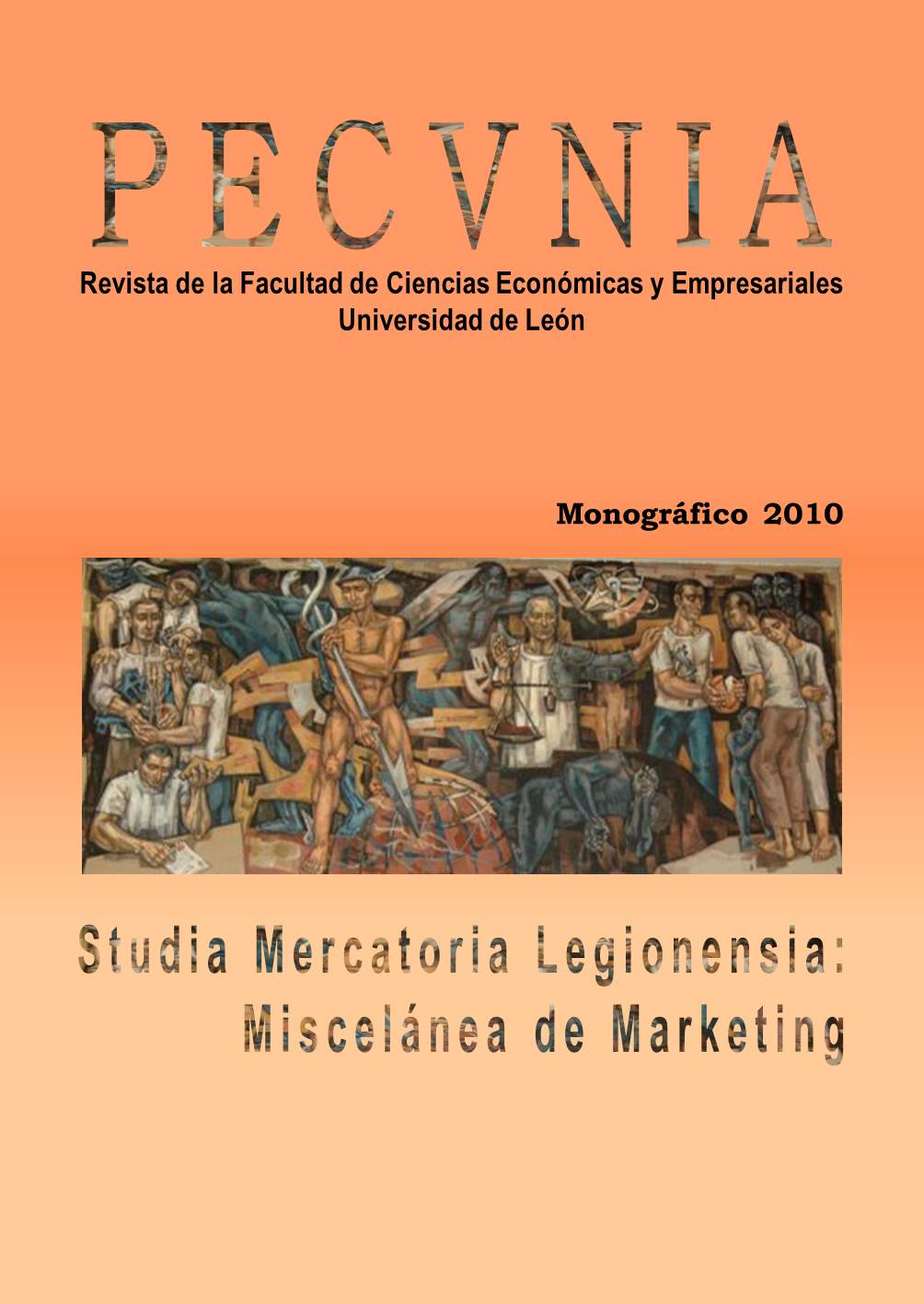Marketing de ciudades y "Place Branding"
DOI:
https://doi.org/10.18002/pec.v0i2010.767Palavras-chave:
Marketing de ciudades, Marketing territorial, Place branding, Identidad, Competencia y cooperación urbana, Redes entre ciudades, Redes culturales, City marketing, Identity, Urban competition and cooperation, Networks among citiesResumo
En esta investigación se analiza el marketing de ciudades en el marco de las marcas territoriales o place branding. Se estudia el concepto de la identidad como referencia de partida a partir del cual desarrollar una estrategia de comercialización urbana, la cual se concibe dentro de un enfoque más amplio de dirección estratégica, y que engloba la transformación física con el urbanismo, las infraestructuras y los aspectos sociales. Este proceso estratégico finaliza con la creación de una comunicación urbana a través de elementos como lemas y logotipos. Se estudia la evolución general del énfasis en los aspectos urbanos clave, desde las infraestructuras y los aspectos industriales a los valores y la creatividad. Asimismo, también se exploran los aspectos derivados de las simbologías urbanas, la formación de redes de ciudades temáticas y redes de notoriedad cultural.This paper analyse the emerging concepts of city marketing and place branding. The concept of identity is studied as a starting reference from which to develop an urban marketing strategy, which is conceived within a context broader strategic management approach, and encompasses a physical regeneration or urbanization transformation, and infrastructure and social aspects. This strategic process ends with creating an urban communication through elements such as slogans and logos. We study the general evolution emphasis on key urban issues, from infrastructure and industrial aspects towards values and creativity. In addition, issues arising from the urban symbolism are also explored, as well as the development of urban networks, and thematic networks of cultural visibility.
Downloads
Referências
Anholt, S. (2007). Competitive identity; the new brand management for nations, cities and regions. Nueva York: Palgrave MacMillan.
Ashworth, G. y Vgoodg, H. (1990). Selling the city. Marketing approaches in public sector urban planning. Londres: Bellhaven Press.
Berg, P.O. (2000). “Dreaming up a region? Strategic management as invocation”. In, Invoking a transnational metropolis. The making of the Øresund region, P.O. Berg, A. Linde-Laursen and O. Löfgren (eds.). Lund (Sweden): Studentlitteratur.
Borja, J. y Castells, M. (1997). Local y global; la gestión de las ciudades en la era de la información. Madrid: Taurus.
Brandenburger, A.M. y Nalebuff, B.J. (1996). Coopetition. Nueva York: Currency Doubleday.
Caldwell, N. (2000) “The emergence of brand museums”. International Journal of Arts Management, vol. 2, n. 3, pp. 28-34.
Castells, M. (1998). La era de la información. Economía, sociedad y cultura. Vol. 1: La Sociedad Red. Vol. 2: El Poder de la Identidad. Madrid: Alianza Editorial.
Cueto, J. (2005). “Ciudades lentas”. El País Semanal, n. 1478, 23 Enero, pp. 8.
Chias, J. (2005). El negocio de la felicidad. Desarrollo y marketing turístico de países, regiones, ciudades y lugares. Madrid: Prentice-Hall.
De Elizagárate, V. (2003/2008). Marketing de ciudades. Madrid: ESIC Pirámide.
Dinnie, K. (2004). “Place branding: Overview of an emerging literature”. Place Branding, vol. 1, n. 1, pp. 106-110.
Fernández Güell, J.M. (2006). Planificación estratégica de ciudades. 2ª ed. Barcelona: Reverté.
Florida, R. (2005). The flight of the creative class; the new global competition for talent. Nueva York: Harper Collins Business.
Gold, J.R. y Ward. S. (1994). Place promotion: The use of publicity and marketing to sell towns and regions. Chichester: John Wiley & Sons.
Gómez, M. (1998). “Reflective images: The case of urban regeneration in Glasgow and Bilbao”. International Journal of Urban and Regional Research, vol. 22, n. 1, pp. 106- 121.
Greenberg, M. (2002). “Branding cities: A social history of the urban lifestyle magazine”.
Urban Affairs Review, vol. 36, n. 2, pp. 228-263.
Kavaratzis, M. (2004). “From city marketing to city branding: Towards a theoretical frame- work for developing city brands”. Place Branding, vol. 1, n. 1, pp. 58-73.
Hauben, T.; Vermeulen, M. y Patteeuw, V. (2002). City branding: Image building and building images. Rotterdam: NAI Uitgevers.
Kolb, B. (2006). Tourism marketing for cities and towns; using branding and events to attract tourists. Oxford: Elsevier.
Kotler, P.; Asplund, C.; Rein, I. y Haider, D. (1999). Marketing places Europe: Attracting investments, industries, residents and visitors to European cities, communities, regions and nations. Londres: Pearson Education.
Kotler, P. y Gertner, D. (2002). “Country as brand, product, and beyond: A place marketing and brand management”. Journal of Brand Management, vol. 9, pp. 249-261.
Landry, C. (2000). The creative city: A toolkit for urban innovators. Londres: Earthscan Publications.
Lodge, C. (2002). “Success and failure: The brand stories of two countries”. Journal of Brand Management; vol. 9, n. 4-5, pp. 372-384.
Jensen-Butler, C.; Arie, S.C. y Weesep, J.V. eds. (1997). European cities in competition. Aldershot: Avebury Books.
Jensen, O.B. y Richardson, T. (2005). “Branding the contemporary city–urban branding as regional growth agenda?”. Conferencia presentada en Regional Studies Conference, 9 de Febrero, Aalborg: Denmark.
Marcas Renombradas Españolas (2005). España marca cultura, de Altamira a las marcas renombradas. Madrid: McGraw Hill.
Moilanen, T. y Rainisto, S. (2009). How to brand nations, cities and destinations; a planning book for place branding. Nueva York: Palgrave MacMillan.
Mommaas, H. (2002). “City branding: the importance of socio-cultural goals”. In, City branding: Image building and building images. T. Hauben, M. Vermeulen and V. Patteeuw (Eds.). Rotterdam: NAI Uitgevers.
Moore, E. (2003). “Branding spaces: The scope of new marketing”. Journal of Consumer Culture, vol. 3, n. 1, pp. 39-60.
Morgan, N.; Pritchard, A. y Piggott, R. (2002). “New Zealand, 100% Pure. The creation of a powerful niche destination brand”. Journal of Brand Management, vol. 9, n. 4-5, pp. 335-354.
Morgan, N.; Pritchard, A. y Pride, R. (2007). Destination branding. Oxford: Elsevier Butter- worth Heinemann.
Newsweek (2006). “The world’s hottest cities”, 3 July, pp. 48-79.
Noisette, P. y Vallerugo, F. (1996). Marketing des villes. París: ESSIC.
Pancorbo de Sandoval, J.A. (1999). Desarrollo de indicadores urbanos en la gestión de marketing de ciudad; Tesis Doctoral realizada y presentada ante tribunal académico en la Universidad de León, España.
Pellenbarg, P.H. y Meester, W.J. (2005). Regional marketing to change regional images. The example of the Groningen campaign: Paper presented at the Academy of Marketing Conference, July 5-8, in Dublin (Ireland).
Porter, M.E. (1998). The competitive advantage of nations, 2ª ed. New York: The Free Press.
Porter, M.E. (2008). “Clusters and competition, new agendas for companies, governments and institutions”. In, On competition, cap. 7. Boston, MA: Harvard Business Press.
Raco, M. (1999). “Competition, collaboration and the new industrial districts: Examining the institutional turn in local economic development”. Urban Studies, vol. 36, n. 5-6, pp. 951-968.
Rainisto, S.K. (2003). Success factors of place marketing: A study of place marketing practices in northern Europe and the United States. Tesis Doctoral. Finlandia: Helsinki University of Technology.
Ries, A. y Trout, J. (1986). Positioning: The battle for your mind. Singapore: McGraw Hill.
Rosemberg, M. (2000). Le marketing urbain en question. París: Anthropos.
Sassen, S. (1991). The global city. New York: Princeton University Press.
Sassen, S. (2002). Global networks, linked cities. New York: Routledge.
Skinner, H. y Kubacki, K. (2007). “Unravelling the complex relationship between na- tionhood, national and cultural identity, and place branding”. Place Branding and Public Diplomacy, vol. 3, special issue paper, pp. 305–316.
Stephenson, R. y Poxon, J. (2001). “Regional strategy making and the new structures and processes for regional governance”. Local Government Studies, vol. 2, n. 1, pp. 109- 124.
Van den Berg, L.; Braun, E. y Van den Meer, E. (1999). “Competitividad y cohesión metropo- litanas. Organización y redes estratégicas”. Papeles de Economía Española, n. 80: Mo- nográfico Regiones y ciudades. Convergencia en clave europea, pp. 248-265.
Van den Berg, L.; Klassen, L.H. y Meer, J. (1990). Marketing metropolitan regions. Rotterdam: EURICUR.
Van den Berg, L.; Braun, E. y Van Winden, W. (2001). “Growth clusters in European cities: An integral approach”. Urban Studies, vol. 38, n. 1, pp. 185-205.
Van Ham, P. (2002). “Branding territory: Inside the wonderful worlds of PR and IR theory”.
Journal of International Studies, vol. 31, n. 2, pp. 249-269.
Vegara, A. y de las Rivas, J.L. (2004). Territorios inteligentes. Madrid: Fundación Metrópoli.
Verdú, V. (2003). El estilo del mundo; la vida en el capitalismo de ficción. Barcelona: Anagrama.
Verdú, V. (2005). Yo y tú, objetos de lujo; el personismo: la primera revolución cultural del siglo XXI. Barcelona: Debate.
Ward, S. (1998). “Place marketing: A historical comparison of Britain and North America”. In, The entrepreneurial city: Geographies of politics, regime and representation, T. Hall and P. Hubbard (Eds.). Chichester: John Wiley.
Wusten, H. (1993). Capital cities in Europe. Amsterdam: CGO Publications.
Downloads
Publicado
Como Citar
Edição
Secção
Licença
Direitos de Autor (c) 2010 Norberto Muñiz Martínez, Miguel Cervantes Blanco

Este trabalho encontra-se publicado com a Licença Internacional Creative Commons Atribuição-NãoComercial-CompartilhaIgual 4.0.
Los autores que publican en esta revista están de acuerdo con los siguientes términos:- Los autores ceden de forma no exclusiva los derechos de explotación (reproducción, distribución, comunicación pública, transformación) a la Universidad de León, por lo que pueden establecer, por separado, acuerdos adicionales para la distribución no exclusiva de la versión de la obra publicada en la revista (por ejemplo, alojarlo en un repositorio institucional o publicarlo en un libro), con un reconocimiento de su publicación inicial en esta revista.
- Este trabajo se encuentra bajo la Creative Commons Attribution-NonCommercial-ShareAlike 4.0 International License. Puede consultarse desde aquí la versión informativa y el texto legal de la licencia.
- Se permite y se anima a los autores a difundir electrónicamente las versiones pre-print (versión antes de ser evaluada) y/o post-print (versión evaluada y aceptada para su publicación) de sus obras antes de su publicación, ya que favorece su circulación y difusión más temprana y con ello un posible aumento en su citación y alcance entre la comunidad académica.












